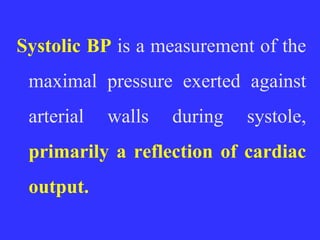Vital_sfffffffffffffffffffffigns-BP-1.ppt
- 1. Systolic BP is a measurement of the maximal pressure exerted against arterial walls during systole, primarily a reflection of cardiac output.
- 2. Diastolic BP is a measurement of pressure remaining in arterial system during diastole (period of relaxation that reflects the pressure remaining in blood vessels after heart has pumped), a reflection of peripheral vascular resistance.
- 3. Pulse Pressure Measurement of the ratio of stroke volume to compliance (total distensibility) of the arterial system.
- 4. BP normal limits ’ü▒120/80 mmHg (adults)
- 5. Determinants of BP ’ü▒Cardiac output ’ü▒Peripheral vascular resistance ’ü▒Blood volume ’ü▒Blood viscosity (Hct. > 60-65%)
- 6. Factors affecting BP ’āś Age (elasticity of the arteries) ’āś Exercise ’āś Stress ’āś Race: African, European American males over 35 years have higher BP. ’āś Gender ’āś medications ’āś Obesity ’āś Diurnal variations ’āś Disease process (complications)
- 7. Assessing BP ’āśSphygmomanometer & stethoscope ’āśElectronic Sphygmomanometer ’āśDoppler US ’āśArterial lines
- 12. Assessing BP Contraindications For Brachial Artery BP Measurement ’ü▒Venous access devices, as IV infusion or AV fistula for renal dialysis ’ü▒Surgery in breast, axilla, shoulder, arm, hand ’ü▒Injury or disease to shoulder, arm, or hand, such as trauma, burns, or cast or bandage
- 13. Assessing BP Hypertension ’ü▒Primary hypertension ’ü▒Secondary hypertension
- 14. Assessing BP (Hypertension) Associated factors include: ’ü▒Smoking ’ü▒Obesity ’ü▒Alcohol ’ü▒Arteriosclerosis ’ü▒Lack of physical activity ’ü▒High blood cholesterol ’ü▒Stress
- 15. Assessing BP (Hypertension) ’ü▒Diagnostic measures: >140/90 mmHg in multiple readings ’ü▒Rx. : treatment of secondary causes, life style changes and monitoring.
- 16. Assessing BP (Hypotension) ’ü▒Orthostatic hypotension ’ü▒Assessment of: drugs, bleeding, severe burn and dehydration ’ü▒Management: supine position 2-3min., V/s, prevent falls, Rx of the cause.
- 17. Orthostatic Postural Hypotension ’ü▒Postural or orthostatic hypotension (sudden; temporary drop in BP when rising from a reclining position) ’ü▒Most common in those with circulatory problems, dehydrated, or those who take diuretics or other drugs that lower BP
- 18. Category Systolic (mmhg) Diastolic (mmhg) Follow-up recommended Optimal <120 <80 / 2 years Normal <130 <85 2 years High normal 130ŌĆō139 85ŌĆō89 1 year Hypertension Stage 1 140ŌĆō159 90ŌĆō99 In 2 months Stage 2 160ŌĆō179 100ŌĆō109 In 1 month Stage 3 180 or higher 110 or higher immediately or in 1 week

















